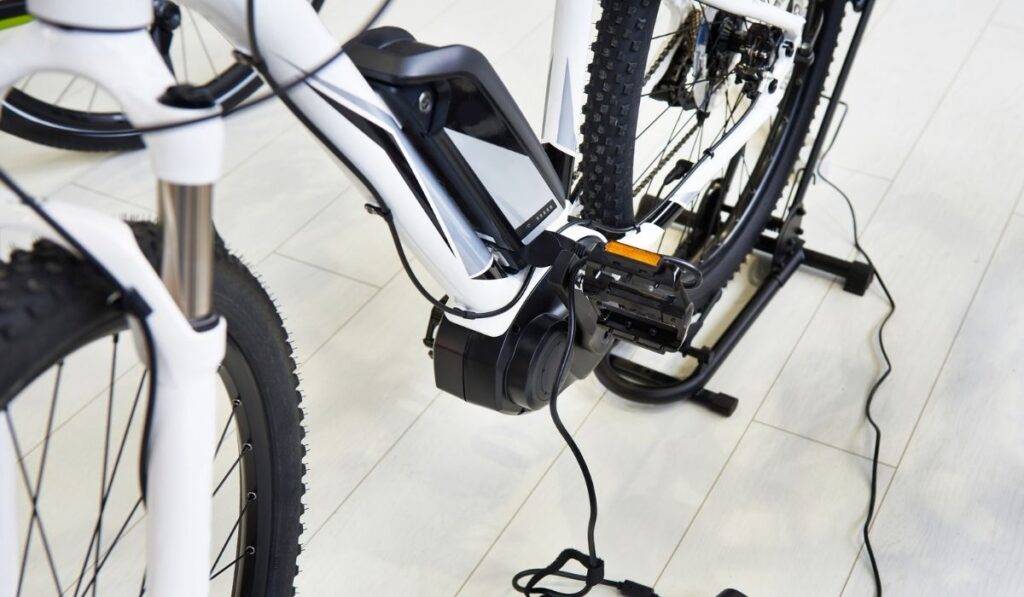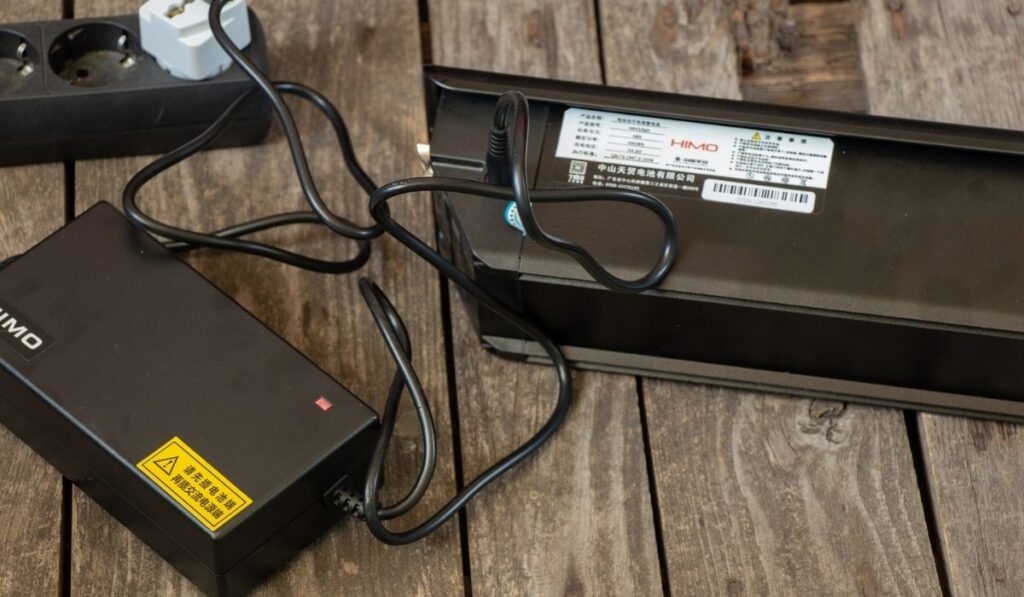When you finally get your hands on your new electric bike, you obviously want to start riding immediately. I mean, who wouldn’t? But, to get the most out of your electric bike, you have to make sure you properly take care of the battery. So, how do you do so?
To make sure your e-bike is properly charged make sure it’s charged to at least 80-90% capacity, and always charge them again before they get under 40%. While charging remember to never leave it unattended, and store it properly while it’s not in use, as neglect can lead to depleted performance and malfunctions.
That may sound like a lot, but when you get the hang of it, it’s really not that much to handle. Charging and caring for your e-bike and battery can become an easy and enjoyable experience. So, what’s the first thing you should do when you get your e-bike? Read on to find out!
What’s the Correct Method for Charging an E-Bike Battery?

When you purchase an electric bike, you may think you can just hop on and go. Unfortunately, that’s not the case. There are proper ways to charge your electric bike battery that will extend its lifespan and even improve its overall performance.
Should You Charge a New E-Bike Battery All The Way?
When you purchase a new electric bike or e-bike battery, you’ll want to fully charge it before riding it. Local shops may do this for you, but make sure you ask them just to be sure. Your bike/battery may come charged at only 30% to 50% capacity if you order it online. Be sure to fully charge it regardless before riding it for the first time.
You should also make sure to fully charge your new bike/battery for its first five charge cycles. This is to balance out your battery and ensure proper performance. These first five cycles may take a little longer to charge, so try to be a little patient. We promise it will be worth it in the long run!
After the first five complete charge cycles, you should make sure to charge your battery to around 80-90% capacity. After that, you should occasionally fully charge it for 2-3 days in a row. Do this fully charged routine around every 30 charge cycles- so make sure to make a note on when to do that.
Let your Battery Fully Cool
A good rule of thumb for charging your battery is to wait at least an hour after your ride to let the battery cool down before charging it. Then connect to your charger and get it to that aforementioned 80-90% capacity. This should become a habit over time. Overall it’s a relatively straightforward process to follow once you get the hang of it.
How To Maintain an E-Bike Battery’s Capacity
There are many other ways to maintain your e-bikes battery capacity, lifespan, and performance. The ways to do this include charging methods, storing methods, and even how you ride. Let’s look at them in a bit more detail.
1. Never Fully Discharge Your Battery
Be sure to avoid entirely discharging your electric bike battery. It’s okay if it happens sometimes, but try to avoid making it a regular occurrence. Fully discharging your e-bike battery uses up one of its full charge cycles. We’ll cover charge cycles, and why this is important), in-depth a bit later in this article. Overall aim to always charge your battery when it hits 20% capacity.
2. Charge Your Battery to 80-90% Capacity
Another way to improve your batteries capacity is by never fully charging it. Fully charging your battery also affects the length of its lifespan. Always charge your battery to no more than 80-90% capacity to ensure the best performance. You can charge it to 100% capacity, but it should be routinely avoided, just like fully discharging.
3. Keep Your Battery Charged When Not in Use
When you aren’t using your e-bike or battery, always keep a little bit of juice left in it. Lithium-ion batteries lose their charge over time, which can impact their lifespan. Leaving about 20-30% charge in your battery when it’s not in use will improve its performance and lifespan over the long term.
4. Store Your Battery at The Correct Temperatures
Besides storing your battery somewhat charged when it’s not in use, you’ll also want to be wary of the temperature at which you store it. Higher temperatures can lessen your battery’s lifespan and performance. Make sure to store batteries between 32°F and 68°F to ensure good performance and safety.
Can You Overcharge an Electric Bike Battery?
Electric bike batteries can definitely be overcharged. This should be avoided as it impacts the lifespan of the battery and can even sometimes be dangerous. That being said, most batteries have smart functions built-in to avoid this.
Since batteries discharge over time if you left one charging it would start to deplete. This can negatively impact the battery’s precious charge cycles, or even cause it to overheat or malfunction.
What’s the Lifespan of an E-Bike Battery?

The lifespan of an e-bike battery is going to vary; depending on how it is charged, the battery type, how it is cared for, and the rider. However, most batteries can be used for between 3-5 years.
As mentioned earlier, one of the factors that impact the lifespan of an e-bike battery is how many charge cycles it has and how many have been used. One full charge cycle is used when a battery is full-charged, fully discharged, and fully charged again. The fewer charge cycles a battery has, the lower the performance, and the closer the battery will be to its eventual death. Most e-bike batteries have a range of 500 to 1,200 charge cycles.
But, what does that look like translated into the real world? Well, assuming you were fully discharging and fully charging your e-bike battery every day, you could get around 2.7 years of use. Or, let’s say you were doing the same thing using an e-bike with a range of 35 miles. In theory, you could travel 35,000 miles before any significant decrease in performance or malfunction.
So, the 3 to 5 years of use range is relatively more accurate as you’re not likely to be fully discharging and charging your battery daily.
What Happens at the End of a Batteries Lifespan?
Reduced range: When a battery reaches the end of its lifespan, you will notice a decrease in the range. You won’t be able to travel as far and potentially as fast as when the battery was in its prime.
Requires frequent charging: Due to the lower capacity of an older battery, you may notice you’ll have to charge it more frequently. This can be a headache and is a sign that it’s time to get a replacement.
Malfunctions: Finally, it will start to break down and malfunction at the end of a battery’s lifespan. The voltage can turn off, components may begin to come loose, and overall the age of the battery will show itself.
What Charge To Store At for Long Term Storage
If you’re a shop owner or aren’t planning to use your bike for a while, you may be wondering what capacity you should leave your battery charged at. Sources often recommend leaving a battery charged at 40-50% capacity when not in use. However, they may only be making that recommendation assuming it won’t be used for a few weeks. So, what’s the verdict?
Consider leaving your e-bike battery at 60-80% capacity when storing it for months at a time. This is an excellent place to be, as it allows a decent amount of time for the battery to self-discharge. That being said, this does have risks and may not always be a viable option.
Alternatively, you can fully charge your e-bike battery, remove the charger, and store it in a climate-controlled environment. But, that still may only be good for less than three months.
If you are storing a battery for the long-term, or over three months, you’ll want to top the battery off while it’s in storage. You should do this in three-month intervals. If you are storing your battery even longer, you’ll want to cycle your battery every six months. Completely drain the battery and fully charge it to complete a cycle.
The main takeaway is batteries require a bit of effort even when not in use. Always be sure to properly store and care for your batteries to avoid potential fires or damages when not in use.
